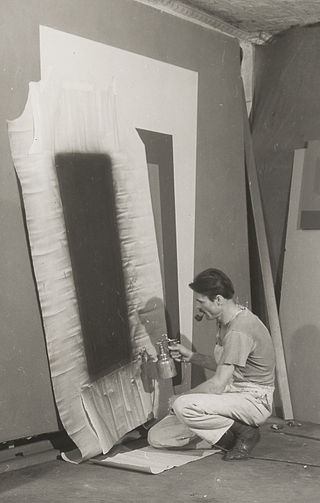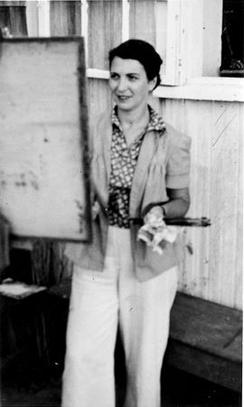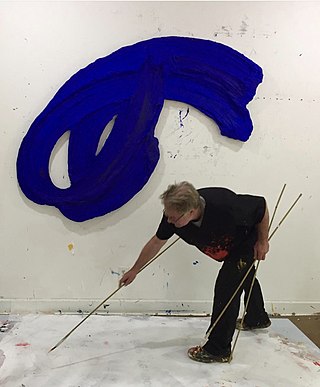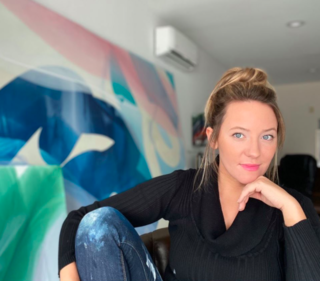Work
Beginning in 1988, Dever worked part time in the architectural firm of Pei Cobb Freed & Partners in New York, while continuing to exhibit his paintings. In 2002 Dever moved to the East End of Long Island, [6] where he embarked on a decade long process, working for 4 years with white paint alone, examining the material properties of oil paint and support. It wasn’t until he had introduced black that he realized he was working with light itself. In 2010, Dever began testing a variety of prepared red hues and selected Naphthol Scarlet, closest in hue to Vermillion, a color 9th century alchemists formulated with sulfur and mercury. Dever’s sudden experience of color was very exciting as the possibilities grew larger and more complex. He began to develop a sense of mixing qualities of light, energy and matter, as one might mix color or hue. The dark hued paintings feel heavy or dense, and those mixed with red appear explosive, others very light, while each painting remains related and part of a whole. Dever’s examination of color phenomena also echo his studies of material nature, as presented in Samkhya philosophy, Patanjali’s Yoga Sutras and the Bhagavad Gita (14.5.) [7]
At Guild Hall in East Hampton, New York, Dever’s 5 x 10 foot cloud inspired painting was placed on stage for Joseph Pintauro’s play, Cloud Life, as part of “The Painting Plays” in 2012. [8] This collaboration, “... Pintauro admires for what he sees as its struggle between Dever’s signature reductive color minimalism and the artist’s morphing into representation...” [9]
In 2014 Berry Campbell exhibited a selection of Dever’s paintings, his first exhibition with the gallery. [10] Two paintings travelled to the US Consulate General of Hong Kong and Macau for an Art in Embassies, Department of State exhibition, 2016-19. A rose from Dever’s garden was the starting point for this group of paintings, which he deconstructed with line and form, revealing the energetic qualities of color. [11]
Dever’s second exhibition with Berry Campbell, “Painting in a House Made of Air,” filled the New York gallery with the artist’s bold use of saturated, electric and sometimes acid color, offering references to Lee Krasner, Joan Mitchell, and Andy Warhol. The paintings build on Dever’s transformation as noted in The East Hampton Star in April 2017, for more than 10 years he had limited his palette to white, black, and red. Dever’s painting now draws inspiration from his garden and the full color spectrum in a new body of work. [12] [13]
An early pandemic studio view in 2020 reveals paintings and a closer look at the unfolding spring palette, informed by walks and the overhead blossoming tree canopy. The resulting paintings often appear weightless as forms dematerialize, reversing figure and ground. [14] Dever was invited to present 12 related paintings mounted on posts in his front yard, featured in The New York Times, for an outdoor “Drive-By” exhibition, which included 52 artists on properties spanning Hampton Bays to Montauk on the South Fork of Eastern Long Island, New York. Social isolation was one theme, while providing a cultural activity during the isolation of the pandemic. [15]
By the end of 2020, Dever had completed an Andy Warhol Foundation/Nature Conservancy-Montauk Project Artist residency. The Warhol Reserve is located at the eastern most tip of Long Island. His paintings from this project highlight the palette of seasonal blue northeastern summer hues. Midpoint through the project, he began exploring adjacent Montauket ancestral lands and vistas. Taking cues from Andy Warhol’s self portrait, pairing complementary or opposite colors, he reimagines a view of Scallop Pond and Paumonok Path, the path itself dedicated to Montauket King, Stephen Talkhouse Pharoah. [16]
Berry Campbell presented in 2022 its third exhibition of paintings by Eric Dever which featured 19 recent paintings created in the artist’s Southampton, New York, studio. The name Dever chose for this body of work, To Look at Things in Bloom, is adapted from a line of verse in the Loveliest of Trees by the English classical scholar and poet, A. E. Housman (1859-1936). These paintings continue the artist’s exploration of nature, inspired by his surroundings from his childhood in Los Angeles to his present-day home in Eastern Long Island. [17] In the exhibition catalogue essay, Gail Levin writes:
“Not surprisingly, Dever’s new pictures do not seek to replicate nature, but instead vibrate between representation and abstraction, a kind of rhythmic dance expressing both what he later recalls in his mind’s eye and, simultaneously, how exhilarated he feels while he loses himself in nature...
Dever doesn’t paint nature, he paints his experience of it. His personal expression calls to mind an earlier painter who also migrated from Los Angeles to New York City to study painting, then moved out to the Hamptons on Long Island’s East End: Jackson Pollock, who famously responded to Hans Hofmann’s question, 'Do you work from nature?' by proclaiming: 'I am nature.' As it did for Pollock, the natural landscape on Long Island offers Dever both stimulation and direction that has found its way into his paintings.
In Dever's Southampton studio, set in the picturesque garden that he himself designed, I looked at the gorgeous diptych Lily of the Nile (also called Agapanthus and featured in another of the new works), and I found myself recalling the garden of Claude Monet (1840-1926), in Giverny, France, which inspired the late paintings of waterlilies that famously disregarded boundaries and moved toward abstraction. Critics have long since linked Monet’s late 'all-over painting' to Pollock’s abstractions. Now Dever’s over-sized depiction of the lavender blue agapanthus, this time extending over two large canvases, continues in this gestural tradition..." [18]
Dever was the 2021/2022 Artist in Residence at the Parrish Art Museum, Water Mill, New York. In 2022, his painting, October 10th , was chosen by the Art in Embassies Program for the United States Embassy Residence in Helsinki, Finland. Sampled colorful morning glory blossoms form the scaffolding of this painting and echo Dever’s self identification with nature. The blossoms themselves reflect the distance and collection of pollen by bees within a 3.6 mile radius of his Water Mill studio garden, where hives are tended on site. Dever’s oeuvre embraces a history of shared growth between the artist, his garden and painting itself. [19] In January 2022, he gave a lecture, Nature into Art, at the Pollock-Krasner House and Study Center, East Hampton, New York. Recently the Heckscher Museum of Art, Huntington, New York, acquired a painting for its permanent collection. [20]
Selected Group Exhibitions
2023 U.S. Embassy residence in Helsinki, Finland. Art in Embassies, Department of State (2023-24) [30]
2022 A Visual Conversation (artist resident project and student collaboration), Parrish Art Museum. Water Mill, New York [31]
2020 Drive-By-Art, Public Art in the Moment of Social Distancing. South Fork, Long Island, New York [32]
2017 Parrish Perspectives: New Works in Context. Parrish Art Museum, Water Mill, New York [33]
Debt Fair, Occupy Museums, Whitney Biennial. Whitney Museum of American Art, New York [34]
2016 U.S. Consulate General Hong Kong and Macau. Art in Embassies, Department of State (2016–19) [35]
2014 Redacted: Connecting Dots Through a Shifting Field. Islip Art Museum, East Islip, New York [36]
2011 Doucement. ParisCONCRET, Paris, France [37]










